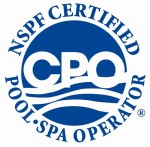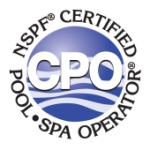Sanitizers – Protecting the User
A sanitizer must work quickly and efficiently to keep the water environment just as healthy for 3 users as for 300 users. There are many sanitizing systems available. The most common pool sanitizer is chlorine and the most common spa sanitizer is bromine. Both sanitizers are excellent oxidizers, which means they destroy or “burn out” contaminants in the water. There are “alternative” sanitizers available which use small amounts of chlorine or bromine to support their system and some that do not use chlorine or bromine at all. For the pool professionals that recommend small amounts of chlorine or bromine be present, just maintain a test result on the free chlorine.
Chlorine
When chlorine enters the water, it is in a form that is an active sanitizer and an oxidizer called “free chlorine”. It will react with any number of contaminants in the water. When it reacts with ammonia compounds in the water, which come from bathers’ perspiration and urine, it becomes “combined chlorine”. In this form, chlorine is a much slower sanitizer. This form also causes chlorine odor and eye irritation.
When the total chlorine reading is higher than the free chlorine reading, it is time to oxidize or destroy the combined chlorine. The simplest way is to increase the chlorine level in the pool to 10 ppm. This higher level of chlorine will oxidize or eliminate the combined chlorine and is called superchlorination or shock treating. Be sure to use a calculation table to determine the correct amount for treatment.
There are also non-chlorine shocks available, such as potassium monopersulfate and sodium dipersulfate. These will eliminate combined chlorine. Keep in mind that these non-chlorine shocks are oxidizers only, not sanitizers. Chlorine or bromine must be added to maintain an adequate level of sanitizer.
Stabilizing your Free Chlorine
In an outdoor swimming pool, the use of a chlorine stabilizer (cyanuric acid) is usually recommended to reduce the degradation of free chlorine by sunlight. Cyanuric acid acts like a shield for chlorine from ultraviolet light. It can be added by itself, usually at an initial dose of 30-40 ppm, or cyanuric acid can be added as part of a chlorine compound. Two forms of chlorine that contain cyanuric acid are known as Sodium Dichloro-s-triazinetrione Dihydrate (dichlor) and Trichloro-s-triazinetrione (trichlor). When these are added to water, they form free chlorine and cyanuric acid. Since trichlor has more active stabilizer and chlorine it usually costs more.
There are three common unstabilized forms of chlorine. They are sodium hypochlorite (liquid bleach), calcium hypochlorite(cal-hypo) and lithium hypochlorite. These are normally used for indoor pools, superchlorination treatments or when cyanuric acid levels are too high.
Chlorine Demand
The National Spa and Pool Institute defines chlorine demand as “the amount of chlorine that will be consumed by readily oxidizable impurities in water”. In simpler terms, if a 3 ppm dosage of chlorine is added and is promptly tested to find only 2 ppm is on hand, the water had a 1 ppm demand. Many things contribute to chlorine demand such as bacteria, organics (like dirt and leaves), fertilizers (including nitrate and phosphate), and bather wastes. When opening a pool in the spring or after a heavy storm, expect higher than usual chlorine demands. Once the demand is met, the remaining free chlorine residual is there to take care of the additional demand.
The ideal free chlorine range for pools is 1-3 ppm and 2-4 for spas.
Chlorine Treatment Compounds
| Trade Name (Proper Name) | % Available | |
| Chlorine | pH | |
| Liquid Chlorine (Sodium Hypochlorite) | 12% | 13.0 |
| Litho (Lithium Hypochlorite) | 35% | 10.7 |
| Cal Hypo (Calcium Hypochlorite) | 65% | 11.8 |
| Dichlor (Sodium Dichloro-s-triazinetrione Dihydrate) | 56% | 6.0 |
| Dichlor (Sodium Dichloro-s-triazinetrione Anhydrous) | 62% | 6.0 |
| Trichlor (Trichloro-s-triazinetrione) | 90% | 3.0 |
Bromine
There are two types of bromine systems. One type is a solid tablet form that is added to a skimmer and feeds sanitizer into the passing water as it slowly dissolves. It contains both bromine and chlorine. The function of the chlorine is to make more bromine when none remains. The second type uses a bromide salt which requires the addition of a separate oxidizer such as chlorine, ozone or non-chlorine shock.
When bromine is added to water, it forms free bromine. Like chlorine, free bromine can also combine with ammonia compounds, but the combined bromine reacts as quickly as free bromine. Thus, there is no need to distinguish between free and combined bromine. A bromine system should be shocked with 10 ppm of chlorine periodically. Spa owners may need to do this frequently. Check with your local chemical supplier for advice.
The ideal range for bromine in pools and spas is 3-6 ppm.
pH
Water Balance – Protecting the Pool or Spa
pH is the measure of the acidity of the water. The pH scale extends from 0 to 14 with 7 being neutral. As the pH moves lower than 7.0, the water becomes more acidic and tends to be corrosive; as pH moves up higher than 7.0, the water becomes less acidic (or more basic) and could lead to a scale forming condition.
Since most water has the tendency to either corrode or leave small, crusty “scale” deposits, it is important to properly balance the factors of pH, total alkalinity and hardness. Depending on where you live, the water can contain a variety of minerals. These minerals directly affect whether the water will corrode, scale or be in balance. In addition to pH, total alkalinity and calcium hardness, temperature plays a role in water balance and must be considered when determining ideal levels in pools or spas. The reason is because in warmer water a substance called calcium carbonate tends to fall out of solution more rapidly, thus leaving behind scale deposits. For example, in 60°F (16°C) pool water, a good practice would be to keep the pH level closer to 7.6 if the alkalinity and hardness are in the ideal range. In 80°F (27°C) pool water, a pH of 7.3 would be best. A professional pool and spa retailer can provide a “saturation index” calculation to target your ideal pH level.
Note: a high pH level (above 7.8), will inhibit the ability of free chlorine to sanitize water efficiently. If your water source has a high pH, the form of chlorine selected can actually help to lower the pH. (For example: If your water source is a pH of 8.2 you may wish to use Trichlor since it has a pH of 3.0). For several reasons, including bather comfort, the ideal pH of pool or spa water is 7.2 – 7.6.
The ideal pH range for pools and spas is 7.2-7.6.
If pH Is Too LOW (Acidic)
- corrosion of pool equipment/staining
- swimmer eye irritation
- etching plaster pool surfaces
- chlorine dissipates quickly
If pH Is Too HIGH (Basic)
- scale accumulates on pool equipment
- cloudy, turbid water
- sanitizing power of chlorine is weakened
- swimmer eye irritation
Total Alkalinity
Total alkalinity refers to the buffering capacity of the water or how well the water can resist changes in pH. If the alkalinity is too low, the pH could potentially change daily. This is known as “pH bounce” and leaves the pool and spa water vulnerable to pH problems from chlorine treatments, environmental conditions and even from fresh make-up water. Low alkalinity water will tend to be corrosive, thus eroding pool surfaces and equipment.
If the alkalinity level is too high, the pH may also drift to a very high level. Then, it is very difficult to reduce the pH and the water may be cloudy and prone to scaling.
The ideal alkalinity range for pools and spas is 80-120 ppm,
100-150 if using cyanuric acid.
Total Hardness
Total hardness refers to the level of dissolved calcium and magnesium in the water. The most common contributor of hardness is from the source water used to fill or top off the pool or spa. Other sources include forms of chlorine, such as calcium hypochlorite, and the intentional addition of calcium chloride. Owners of plaster pools should make concerted efforts to avoid low hardness levels especially when opening a new pool. Water is naturally, a “universal solvent” and if the hardness level is too low, the plaster can be rapidly dissolved from the pool walls. In other types of pools or spas it is important to keep hardness levels within adequate ranges in order to prevent etching or dissolving other hardware components, such as heaters and plumbing.
If the hardness level is too high, the water can become cloudy and scale may form on pool surfaces and equipment. Scale will appear as small white deposits at the water level on walls, ladders, and numerous other places that the owner may not see. If left uncorrected, scale can clog pipes and filters, as well as damage heaters.
Fortunately, there is a point where water is not corrosive or scale forming. By keeping the hardness, alkalinity and pH factors within their ideal ranges, the water is balanced and the pool or spa will provide many years of trouble-free use.
The ideal range for total hardness for pools is 250-500 ppm and for spas is 200-350. This can vary by regional water hardness.




